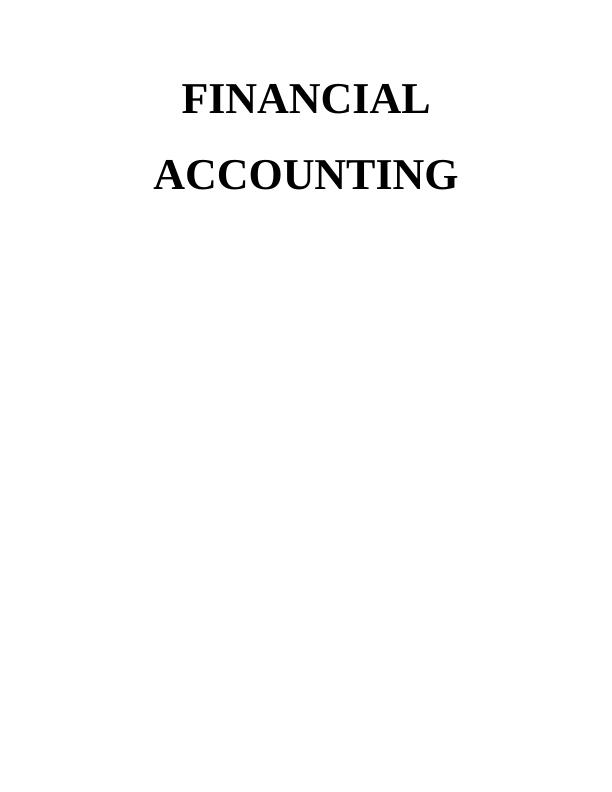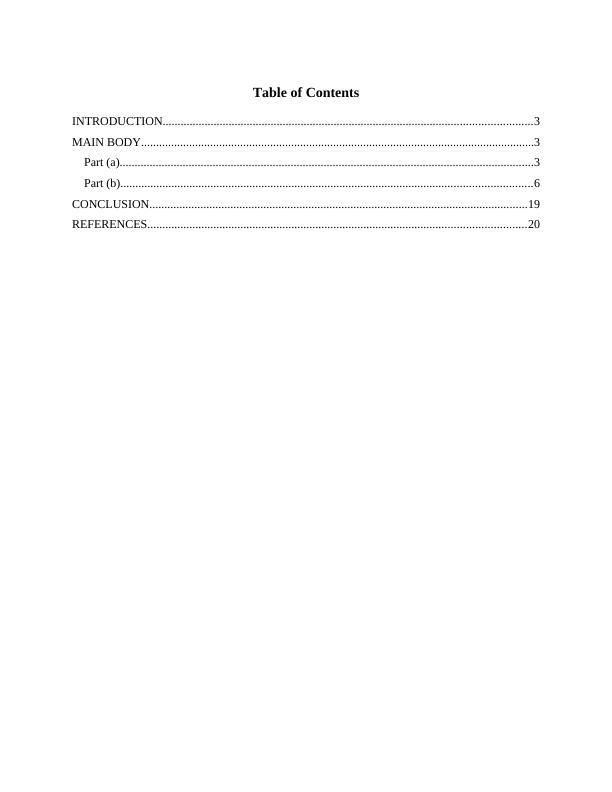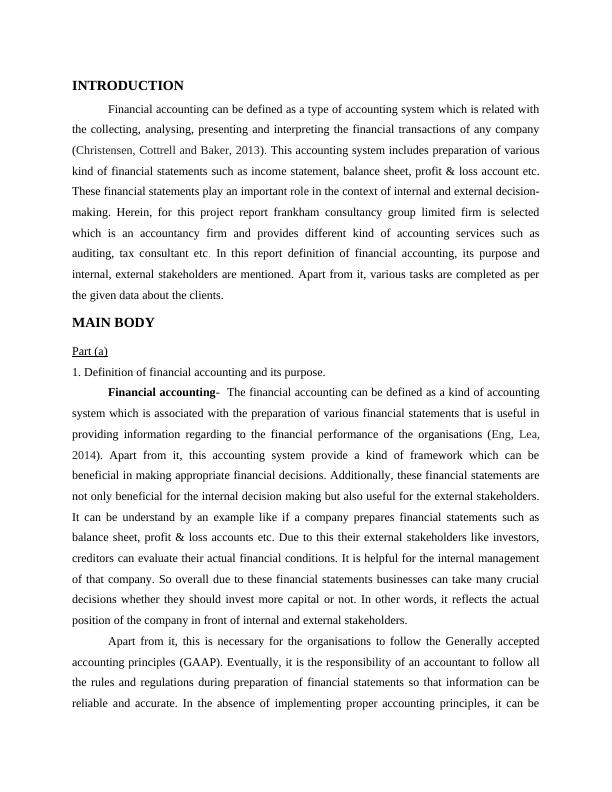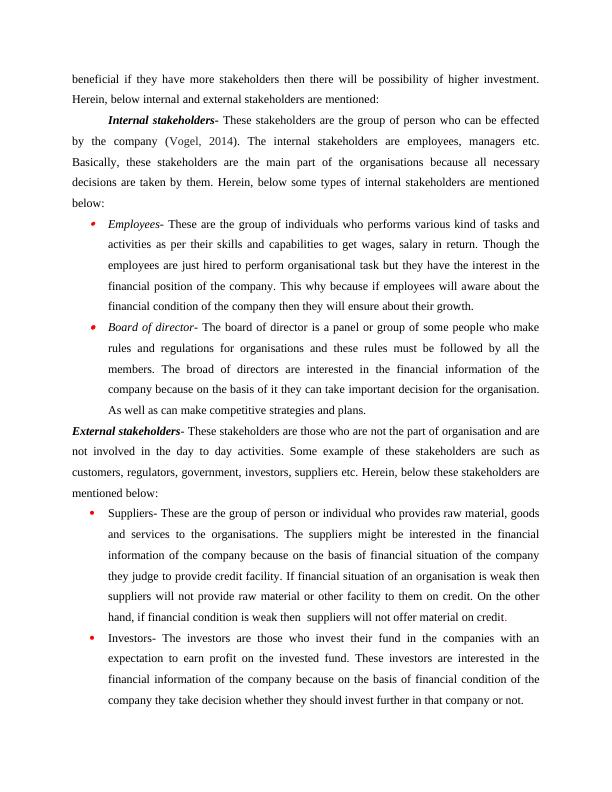Introduction to Financial Accounting (pdf)
25 Pages4847 Words60 Views
Added on 2021-02-21
Introduction to Financial Accounting (pdf)
Added on 2021-02-21
ShareRelated Documents
FINANCIAL
ACCOUNTING
ACCOUNTING

Table of Contents
INTRODUCTION...........................................................................................................................3
MAIN BODY...................................................................................................................................3
Part (a)..........................................................................................................................................3
Part (b).........................................................................................................................................6
CONCLUSION..............................................................................................................................19
REFERENCES..............................................................................................................................20
INTRODUCTION...........................................................................................................................3
MAIN BODY...................................................................................................................................3
Part (a)..........................................................................................................................................3
Part (b).........................................................................................................................................6
CONCLUSION..............................................................................................................................19
REFERENCES..............................................................................................................................20

INTRODUCTION
Financial accounting can be defined as a type of accounting system which is related with
the collecting, analysing, presenting and interpreting the financial transactions of any company
(Christensen, Cottrell and Baker, 2013). This accounting system includes preparation of various
kind of financial statements such as income statement, balance sheet, profit & loss account etc.
These financial statements play an important role in the context of internal and external decision-
making. Herein, for this project report frankham consultancy group limited firm is selected
which is an accountancy firm and provides different kind of accounting services such as
auditing, tax consultant etc. In this report definition of financial accounting, its purpose and
internal, external stakeholders are mentioned. Apart from it, various tasks are completed as per
the given data about the clients.
MAIN BODY
Part (a)
1. Definition of financial accounting and its purpose.
Financial accounting- The financial accounting can be defined as a kind of accounting
system which is associated with the preparation of various financial statements that is useful in
providing information regarding to the financial performance of the organisations (Eng, Lea,
2014). Apart from it, this accounting system provide a kind of framework which can be
beneficial in making appropriate financial decisions. Additionally, these financial statements are
not only beneficial for the internal decision making but also useful for the external stakeholders.
It can be understand by an example like if a company prepares financial statements such as
balance sheet, profit & loss accounts etc. Due to this their external stakeholders like investors,
creditors can evaluate their actual financial conditions. It is helpful for the internal management
of that company. So overall due to these financial statements businesses can take many crucial
decisions whether they should invest more capital or not. In other words, it reflects the actual
position of the company in front of internal and external stakeholders.
Apart from it, this is necessary for the organisations to follow the Generally accepted
accounting principles (GAAP). Eventually, it is the responsibility of an accountant to follow all
the rules and regulations during preparation of financial statements so that information can be
reliable and accurate. In the absence of implementing proper accounting principles, it can be
Financial accounting can be defined as a type of accounting system which is related with
the collecting, analysing, presenting and interpreting the financial transactions of any company
(Christensen, Cottrell and Baker, 2013). This accounting system includes preparation of various
kind of financial statements such as income statement, balance sheet, profit & loss account etc.
These financial statements play an important role in the context of internal and external decision-
making. Herein, for this project report frankham consultancy group limited firm is selected
which is an accountancy firm and provides different kind of accounting services such as
auditing, tax consultant etc. In this report definition of financial accounting, its purpose and
internal, external stakeholders are mentioned. Apart from it, various tasks are completed as per
the given data about the clients.
MAIN BODY
Part (a)
1. Definition of financial accounting and its purpose.
Financial accounting- The financial accounting can be defined as a kind of accounting
system which is associated with the preparation of various financial statements that is useful in
providing information regarding to the financial performance of the organisations (Eng, Lea,
2014). Apart from it, this accounting system provide a kind of framework which can be
beneficial in making appropriate financial decisions. Additionally, these financial statements are
not only beneficial for the internal decision making but also useful for the external stakeholders.
It can be understand by an example like if a company prepares financial statements such as
balance sheet, profit & loss accounts etc. Due to this their external stakeholders like investors,
creditors can evaluate their actual financial conditions. It is helpful for the internal management
of that company. So overall due to these financial statements businesses can take many crucial
decisions whether they should invest more capital or not. In other words, it reflects the actual
position of the company in front of internal and external stakeholders.
Apart from it, this is necessary for the organisations to follow the Generally accepted
accounting principles (GAAP). Eventually, it is the responsibility of an accountant to follow all
the rules and regulations during preparation of financial statements so that information can be
reliable and accurate. In the absence of implementing proper accounting principles, it can be

difficult for the companies to take risky decisions. For this purpose, organisations conduct
auditing process so that accuracy of financial statements can be analysed. Herein, some purposes
of financial accounting are mentioned below: Provide financial information- The basic purpose of financial accounting is to provide
needed reliable financial information with the help of different kind of financial accounts
such as balance sheet, income statements etc. Provide framework for decision-making- The financial accounting is also helpful in
taking many crucial and important decisions on the basis of prepared financial statements
(Knežević, Stanković and Tepavac, 2012). Helpful in taking taxation decisions- Additionally, this accounting system is useful in
taking taxation decision. On the basis of income and expenditures companies can
calculate the actual taxation. Helps in comparison- Due to the financial accounting system, companies can compare
their current year's profits and expenditures from past year. It can be possible by
comparison of previous year's profit & loss account and balance sheets with current year.
With the help of it, organisation can analyse their actual condition.
Beneficial in making future plans and strategies- The another purpose of financial
accounting system is that on the basis of financial information, companies can make their
further plans and competitive strategies. It becomes possible because several financial
statements consist important which can be useful in making important strategies. Helpful in attracting investors- If company's financial statements are presenting better
financial condition then it can be profitable for them to attract more investors. This is
why because investors make invest on the basis of financial condition and it is provided
by financial accounting in the form of income statements, balance sheet etc.
2. Internal and external stakeholders.
Stakeholder- It can be defined as a person or group of person who are interested in the
activities of any business. The main purpose of them to show the interest is to evaluate financial
position so that they can make invest in companies. Eventually, there are two types of
stakeholders which are internal and external stakeholders. If companies change their plans,
policies and strategies then it impacts to the stakeholders. As well as for organisations it is
auditing process so that accuracy of financial statements can be analysed. Herein, some purposes
of financial accounting are mentioned below: Provide financial information- The basic purpose of financial accounting is to provide
needed reliable financial information with the help of different kind of financial accounts
such as balance sheet, income statements etc. Provide framework for decision-making- The financial accounting is also helpful in
taking many crucial and important decisions on the basis of prepared financial statements
(Knežević, Stanković and Tepavac, 2012). Helpful in taking taxation decisions- Additionally, this accounting system is useful in
taking taxation decision. On the basis of income and expenditures companies can
calculate the actual taxation. Helps in comparison- Due to the financial accounting system, companies can compare
their current year's profits and expenditures from past year. It can be possible by
comparison of previous year's profit & loss account and balance sheets with current year.
With the help of it, organisation can analyse their actual condition.
Beneficial in making future plans and strategies- The another purpose of financial
accounting system is that on the basis of financial information, companies can make their
further plans and competitive strategies. It becomes possible because several financial
statements consist important which can be useful in making important strategies. Helpful in attracting investors- If company's financial statements are presenting better
financial condition then it can be profitable for them to attract more investors. This is
why because investors make invest on the basis of financial condition and it is provided
by financial accounting in the form of income statements, balance sheet etc.
2. Internal and external stakeholders.
Stakeholder- It can be defined as a person or group of person who are interested in the
activities of any business. The main purpose of them to show the interest is to evaluate financial
position so that they can make invest in companies. Eventually, there are two types of
stakeholders which are internal and external stakeholders. If companies change their plans,
policies and strategies then it impacts to the stakeholders. As well as for organisations it is

beneficial if they have more stakeholders then there will be possibility of higher investment.
Herein, below internal and external stakeholders are mentioned:
Internal stakeholders- These stakeholders are the group of person who can be effected
by the company (Vogel, 2014). The internal stakeholders are employees, managers etc.
Basically, these stakeholders are the main part of the organisations because all necessary
decisions are taken by them. Herein, below some types of internal stakeholders are mentioned
below: Employees- These are the group of individuals who performs various kind of tasks and
activities as per their skills and capabilities to get wages, salary in return. Though the
employees are just hired to perform organisational task but they have the interest in the
financial position of the company. This why because if employees will aware about the
financial condition of the company then they will ensure about their growth. Board of director- The board of director is a panel or group of some people who make
rules and regulations for organisations and these rules must be followed by all the
members. The broad of directors are interested in the financial information of the
company because on the basis of it they can take important decision for the organisation.
As well as can make competitive strategies and plans.
External stakeholders- These stakeholders are those who are not the part of organisation and are
not involved in the day to day activities. Some example of these stakeholders are such as
customers, regulators, government, investors, suppliers etc. Herein, below these stakeholders are
mentioned below:
Suppliers- These are the group of person or individual who provides raw material, goods
and services to the organisations. The suppliers might be interested in the financial
information of the company because on the basis of financial situation of the company
they judge to provide credit facility. If financial situation of an organisation is weak then
suppliers will not provide raw material or other facility to them on credit. On the other
hand, if financial condition is weak then suppliers will not offer material on credit.
Investors- The investors are those who invest their fund in the companies with an
expectation to earn profit on the invested fund. These investors are interested in the
financial information of the company because on the basis of financial condition of the
company they take decision whether they should invest further in that company or not.
Herein, below internal and external stakeholders are mentioned:
Internal stakeholders- These stakeholders are the group of person who can be effected
by the company (Vogel, 2014). The internal stakeholders are employees, managers etc.
Basically, these stakeholders are the main part of the organisations because all necessary
decisions are taken by them. Herein, below some types of internal stakeholders are mentioned
below: Employees- These are the group of individuals who performs various kind of tasks and
activities as per their skills and capabilities to get wages, salary in return. Though the
employees are just hired to perform organisational task but they have the interest in the
financial position of the company. This why because if employees will aware about the
financial condition of the company then they will ensure about their growth. Board of director- The board of director is a panel or group of some people who make
rules and regulations for organisations and these rules must be followed by all the
members. The broad of directors are interested in the financial information of the
company because on the basis of it they can take important decision for the organisation.
As well as can make competitive strategies and plans.
External stakeholders- These stakeholders are those who are not the part of organisation and are
not involved in the day to day activities. Some example of these stakeholders are such as
customers, regulators, government, investors, suppliers etc. Herein, below these stakeholders are
mentioned below:
Suppliers- These are the group of person or individual who provides raw material, goods
and services to the organisations. The suppliers might be interested in the financial
information of the company because on the basis of financial situation of the company
they judge to provide credit facility. If financial situation of an organisation is weak then
suppliers will not provide raw material or other facility to them on credit. On the other
hand, if financial condition is weak then suppliers will not offer material on credit.
Investors- The investors are those who invest their fund in the companies with an
expectation to earn profit on the invested fund. These investors are interested in the
financial information of the company because on the basis of financial condition of the
company they take decision whether they should invest further in that company or not.

Creditors- The creditors are those who gives fund or goods on credit to the companies.
Eventually, they give the credit on the basis of financial condition of the organisation.
They show their interest in the financial information of the company to check their
profitability, borrowings etc. On the basis of their financial condition, creditors lend
money to the companies. Government- Eventually, the government is one of the important stakeholder for the
companies. They set the particular laws, rules and regulations which must be followed by
the organisations. They might be interested in the financial information of the companies
so that tax rate can be determined of the organisations.
Part (b)
Client 1.
Journals- In the context of accounting, journal entry means putting the financial
transactions in an accounting journal that defines debit and credit balance (Aiken, 2013). Herein,
it is important that addition of debit and credit side must be equal.
Owner's capital- The account of owner's capital defines about how much capital from the
total capital is invested by the owner of company.
(a) Journal Entries and Ledgers in the book of Alexandra Study
Eventually, they give the credit on the basis of financial condition of the organisation.
They show their interest in the financial information of the company to check their
profitability, borrowings etc. On the basis of their financial condition, creditors lend
money to the companies. Government- Eventually, the government is one of the important stakeholder for the
companies. They set the particular laws, rules and regulations which must be followed by
the organisations. They might be interested in the financial information of the companies
so that tax rate can be determined of the organisations.
Part (b)
Client 1.
Journals- In the context of accounting, journal entry means putting the financial
transactions in an accounting journal that defines debit and credit balance (Aiken, 2013). Herein,
it is important that addition of debit and credit side must be equal.
Owner's capital- The account of owner's capital defines about how much capital from the
total capital is invested by the owner of company.
(a) Journal Entries and Ledgers in the book of Alexandra Study

End of preview
Want to access all the pages? Upload your documents or become a member.
Related Documents
Financial Accounting Principles Assignment - Solutionlg...
|26
|4897
|64
FINANCIAL ACCOUNTING INTRODUCTION 3 MAIN BODYlg...
|25
|2659
|436
FNSORG505 Provide Financial and Business Performance Information Assessmentlg...
|7
|1051
|176
Financial Reporting of Qualitative Characteristics - PDFlg...
|18
|5012
|257
Financial Accounting Principles : Stakeholderlg...
|29
|3429
|88
Financial Reporting Solved Assignment - Doclg...
|15
|4799
|44
